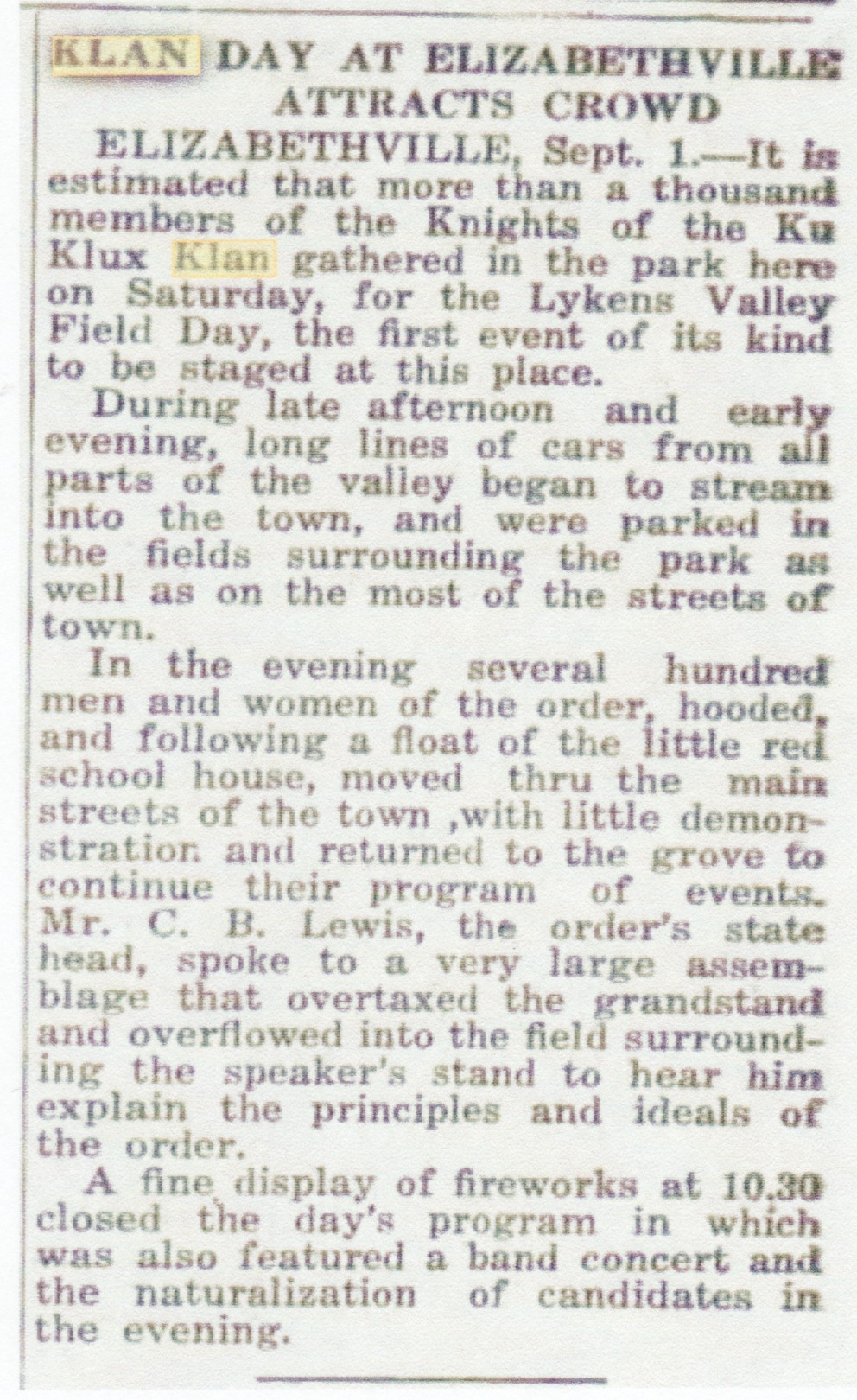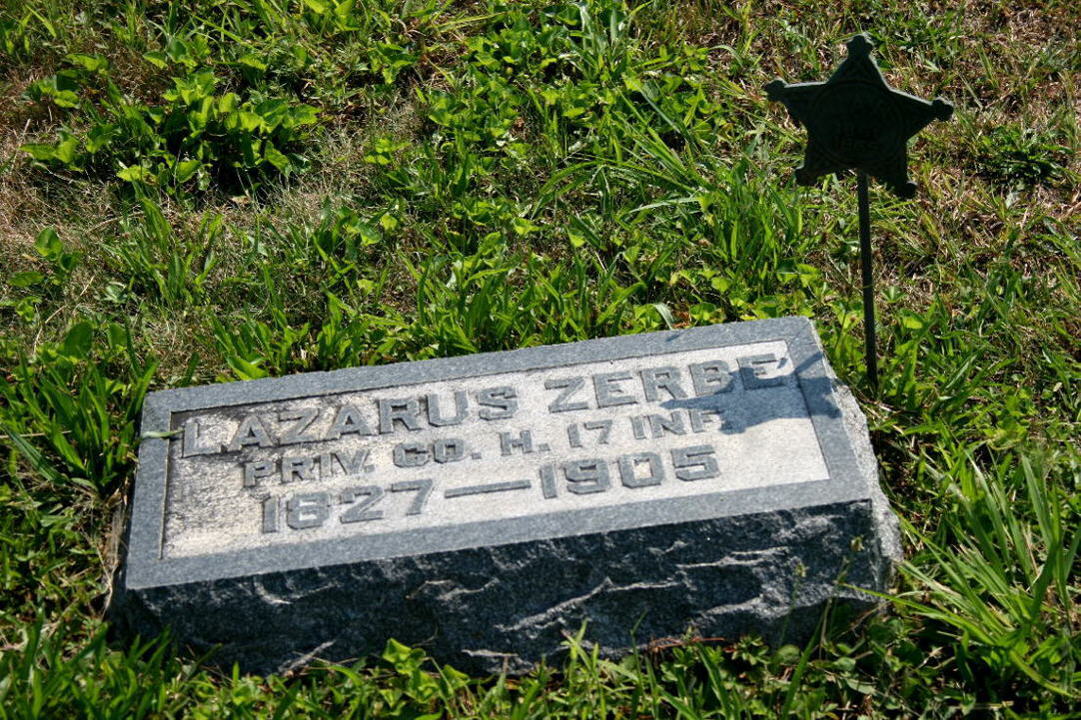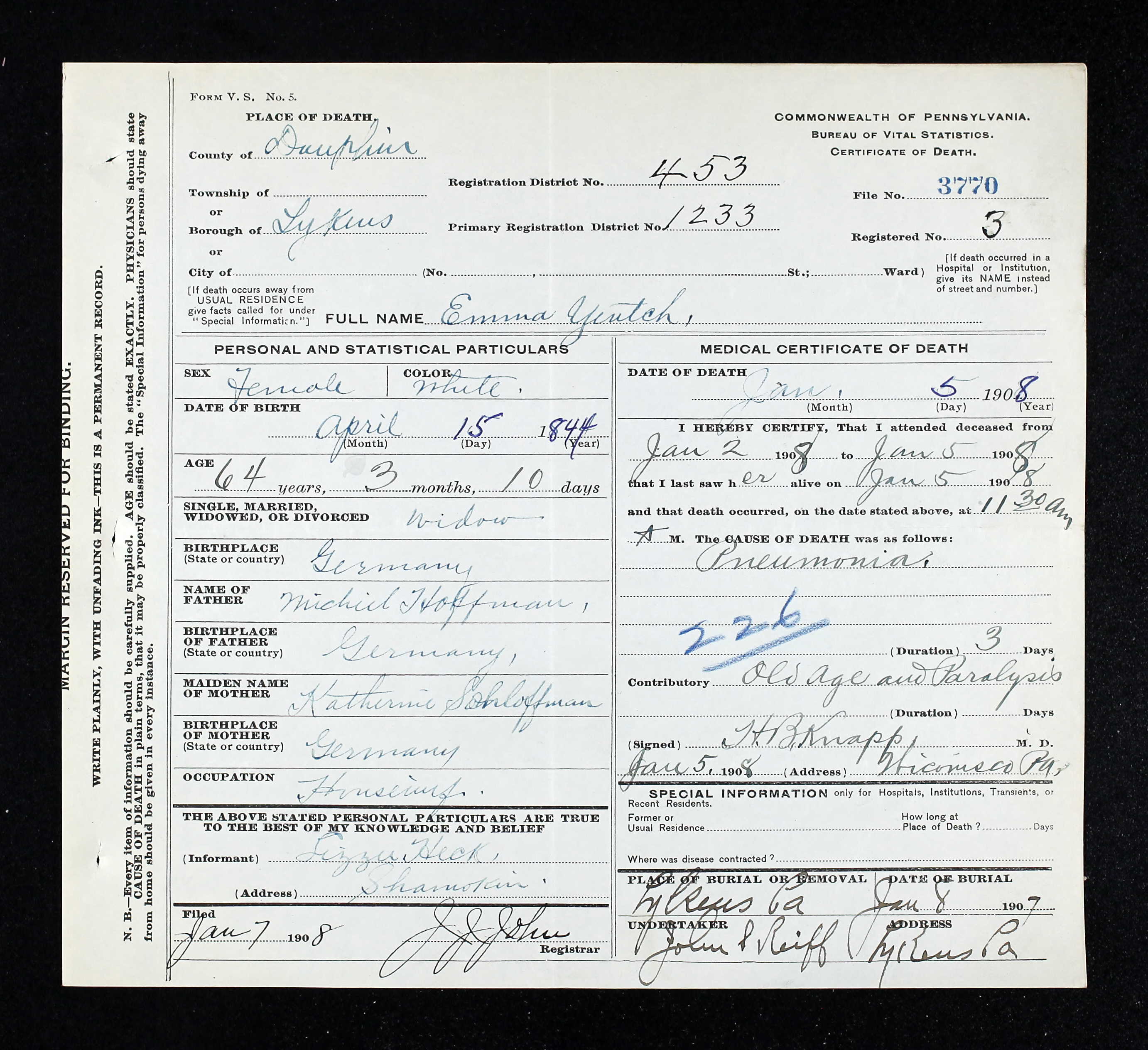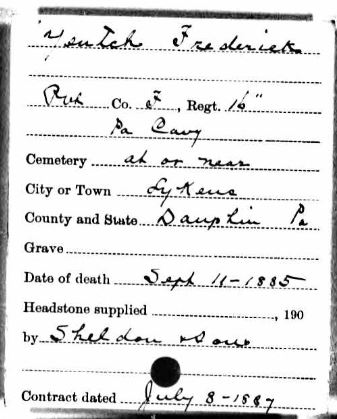Posted By Norman Gasbarro on April 2, 2018
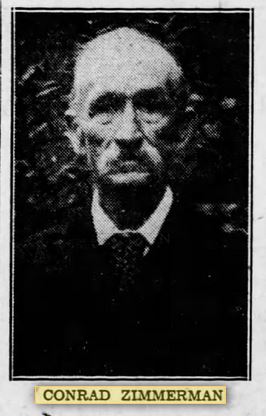
The death of Conrad Zimmerman in Halifax, Dauphin County, on 22 October 1930, was widely reported in area newspapers because he was the last surviving member of a G.A.R. post that had disbanded. The portrait above was published in the Harrisburg Telegraph of 24 October 1930. What was not stated in any of the articles was that Conrad Zimmerman was not married, but for about 30 years prior to his death lived with an African American woman, Roxie Weaver, who survived him and who inherited his estate. Roxie was younger than Conrad and did not die until 1962; she is buried next to him at the United Methodist Cemetery in Halifax.
More research needs to be done on Roxie Weaver, including her parentage which may be Joseph Weaver (1822-1890) and Rebecca [Novinger] Weaver (1826-1899), both of Halifax.
The major purpose of this blog post is to provide the text of the various news articles reporting the death of Conrad Zimmerman. Noteworthy about some of those articles is the statement that he was living with his sister, Mrs. Elizabeth [Zimmerman] Caslow, and not Roxie Weaver. Mrs. Caslow had actually died in 1918.

From the Harrisburg Telegraph, 24 October 1930:
LAST MEMBER OF DISBANDED G.A.R. POST DIES AT 88
Halifax, 24 October 1930 — Conrad Zimmerman, the last surviving member of the once strong H. W. Slocum Post No. 523, Grand Army of the Republic, long since disbanded because of the fast thinning ranks of the Boys in Blue who bravely answered their country’s call in the Civil War of 1861-1865, has answered his final roll-call.
Mr. Zimmerman, who was born in Powl’s Valley, in 1842 had been a prominent citizen of Halifax for many years, residing at the home of his sister Mrs. H. R. Caslow on Front Street where he died on Wednesday afternoon after a week’s illness at the age of 88.
He enlisted February 1864 as a private in company D, later Company I, of the 46th Regiment, Pennsylvania Volunteer Infantry [46th Pennsylvania Infantry], taking part in the following engagements: Resaca, Georgia; Kenesaw [&] Peach Tree, Georgia; Averaboro, North Carolina; Raleigh, North Carolina; and Richmond, Virginia. He was honorably discharged at the close of the war at Alexandria, Virginia.
He was a member of Charity Lodge, No. 82, Independent Order of Odd Fellows, of this place for a period of fifty-six years. He was also Past Grand and since the death of James M. Hoffman had the distinction of being the oldest member of Charity lodge. He was also a member of Odell Rebekah Lodge No. 550, and the local Methodist Episcopal church for many years.
With the passing of Zimmerman there is but one Civil War veteran left in this community, Samuel R. Weaver, South Fourth Street.
Funeral service will be held from the residence at 2 o’clock Sunday afternoon, the Rev. M. Corwin Taylor, pastor of the Methodist Episcopal Church, officiating. Full military honors will be given the veteran at the burial by members of Lloyd-Wiliam Post, No. 648, American Legion. Members of Charity Lodge of Odd Fellow will meet at their hall at 1:30 o’clock Sunday and attend the funeral in a body to pay last tribute to their oldest member.
Nathan Zimmerman, a brother of Carsonville, his only survivor.
Note that the above article indicates that Conrad Zimmerman died at the home of his sister, Mrs. H. R. Caslow. However, genealogical records indicate that Mrs. Elizabeth [Zimmerman] Caslow, the widow of Dr. Heinrich R. Caslow, who was killed on the railroad in April 1880, had herself died in 1918. Note also that the obituary states that a brother Nathan was his only survivor.
_________________________________
Another Harrisburg paper reported that Conrad Zimmerman was survived by his sister, Mrs. Caslow:
From the Harrisburg Sunday Courier, 26 October 1930:
TAPS SOUND FOR HALIFAX G.A.R. POST
H. W. Slocum Post, No. 523, G.A.R. Becomes But a Memory Today
Conrad Zimmerman, 88,
Last Surviving Member to Be Buried With Military Honors This Afternoon
Halifax, 25 October 1930 — When taps are sounded and the last volley is fired over the grave of Conrad Zimmerman, Civil War Veteran, this afternoon, it will also mark the passing of the once strong H. W. Slocum Post, No. 523, Grand Army of the Republic.
Mr. Zimmerman, who was the last surviving member, answered the last roll call on Wednesday at the home of his sister, Mrs. H. R. Caslow, Front Street, with whom he resided, at the age of 88 years. Born in Powl’s Valley in 1842, he became a prominent citizen in this community and for many years was active in civic and social affairs.
He enlisted February 1864, as a Private in Company D, later Company I, of the 46th Regiment, Pennsylvania Volunteers Infantry, taking part in the following engagements: Resaca, Georgia; Kenesaw Peach Tree, Georgia; Averasboro, North Carolina; Raleigh, North Carolina; and Richmond, Virginia. He was honorably discharged at the close of the war at Alexandria.
He was a member of Charity Lodge No. 82, Independent Order of Odd Fellows, of this place for a period of fifty-six years. He was also Past Grand and since the death of James M. Huffman had the distinction of being the oldest member of charity Lodge. He was also a member of Odell Debekah Lodge No. 550, and local Methodist Episcopal Church for many years.
Funeral services will be held from the residence at 2 o’clock this afternoon, the Rev. M. Corwin Taylor, pastor of the church, officiating. Full military honors will be given the veteran at the burial by members of the Lloyd-William Post, No. 648 American Legion. Members of the Charity Lodge will meet at their hall at 1:30 o’clock Sunday and attend the funeral in a body to pay last tribute to their oldest member.
Mr. Zimmerman is survived by his sister, Mrs. Caslow, and one brother, Nathan Zimmerman, of Carsonville.
Of the fast thinning ranks of the “Boys in Blue” who answered their country’s call back in ’61, there remains but one in this community, Samuel R. Weaver, South Fourth Street.
________________________________
Note: The proof that Mrs. Elizabeth [Zimmerman] Caslow had died in 1918, is her death certificate, shown below from Ancestry.com. Mrs. Caslow is buried at the United Methodist Cemetery in Halifax and her grave marker reflects the 1918 date of death.
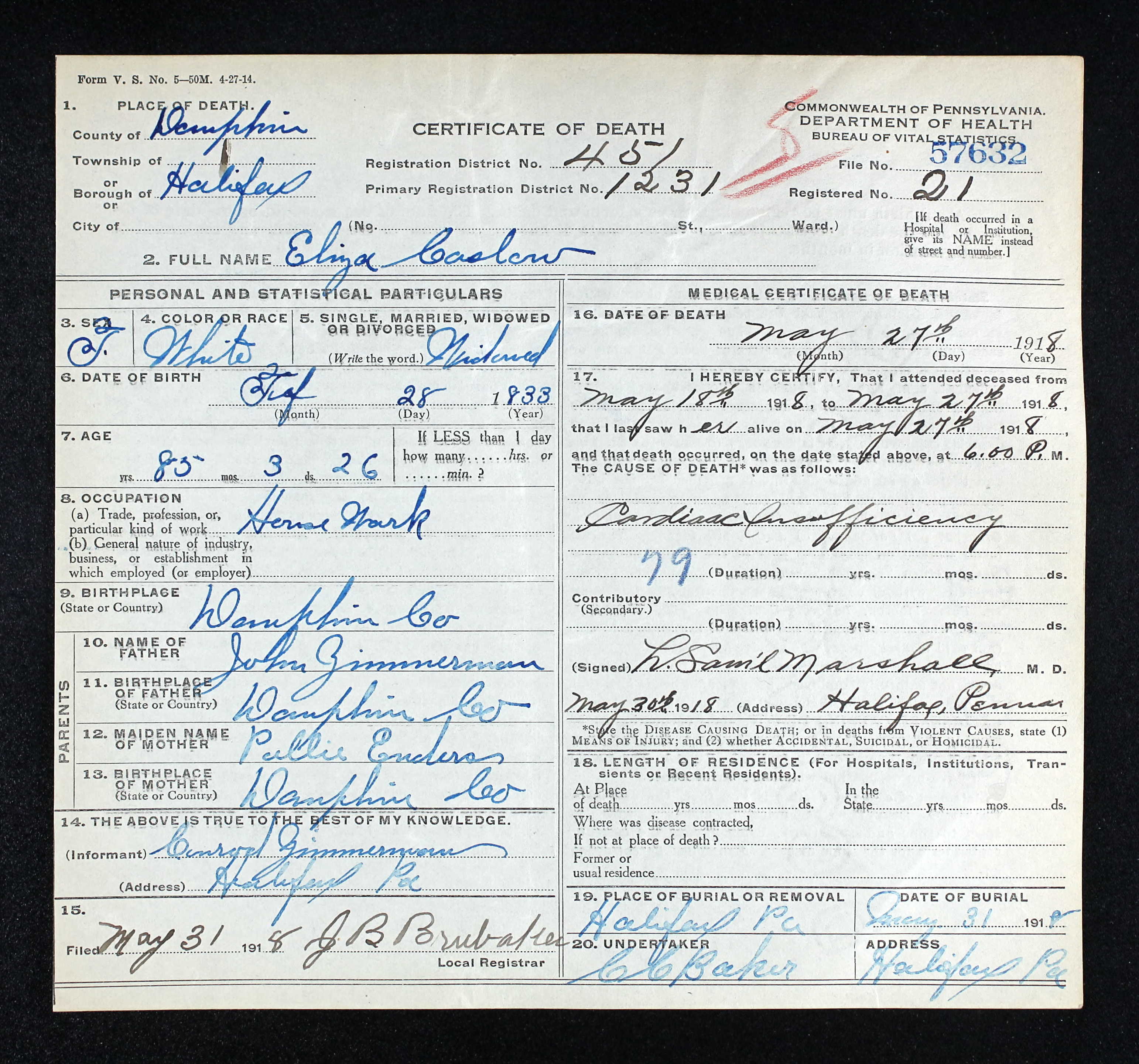 ______________________________
______________________________
The Harrisburg Telegraph of 23 October 1930 had previously reported that Conrad Zimmerman had died at his home, his deceased sister was not mentioned, and the brother Nathan was named as the only survivor. The text of the 23 October 1930 article follows here:
CONRAD ZIMMERMAN
Halifax, 23 October 1930 — Funeral services for Conrad Zimmerman, 88, who died yesterday morning at his home will be held Sunday afternoon at 2 o’clock at the home with the Rev. Corwin Taylor, pastor of the Methodist Church officiating, assisted by the Rev. H. C. Mathias, pastor of the United Brethren Church. Burial will be in the Halifax Cemetery. The body may be viewed at the home on Saturday evening after 7 o’clock.
Mr. Zimmerman is survived by a brother, Nathan Zimmerman, of Carsonville. He was a member of Company I, 46th Regiment, Pennsylvania Volunteers under Captain Joseph Matchett and received his honorable discharge on 16 Jul 1865.
Mr. Zimmerman was the oldest past noble grand of Charity Lodge, No. 82, I. O. O. F., of Halifax; a member of Rebecca Lodge, No. 250; and the Methodist Church.
______________________________
From the local newspapers, the Elizabethville Echo was first to report the following on 20 October 1930. The Echo erroneously noted that the sister, Mrs. Carson, was a survivor.
Halifax G.A.R. Vet Buried Sunday
Funeral services for Conrad Zimmerman, age 88 years, who died at his home in Halifax last Wednesday, were held at two o’clock, Sunday afternoon. Rev. Corwin Taylor, pastor of the Halifax Methodist Church officiated and interment was made in the cemetery at that place. A brother, Nathan Zimmerman of Carsonville, and a sister, Mrs. H. R. Carson, with whom he made his home are the only survivors.
Mr. Zimmerman was a native of Powls Valley and was born in 1842.
He enlisted February 1864 and served during the war with the 46th Regiment, Pennsylvania Volunteers, which saw active service and participated in engagements in Kenesaw, Averasboro, Raleigh, North Carolina, and Virginia. He received an honorable discharge at the end of the war.
Mr. Zimmerman was affiliated with the Halifax lodge of Odd Fellows for fifty-six years and was its oldest member. He was also a member of the Methodist Church of that town for many years.
Members of the Halifax American Legion Post accorded the veteran full military honors at the grave and members of the Halifax lodge of Odd Fellows attended the services in a body. Mr. Zimmerman’s death leaves but one Civil War veteran as a resident of Halifax, he being Samuel R. Weaver.
____________________________
Four days later, 214 October 1930, the Lykens Standard got it right as to the survivors:
OLDEST RESIDENT DIES IN HALIFAX
Conrad Zimmerman, a Civil War veteran and the oldest resident of Halifax, died Wednesday morning at his home. He was 88 years old.
He was a member of Company I, 46th Regiment, Pennsylvania Volunteers under command of Capt. Joseph Matchett, and served throughout the war, receiving his honorable discharge on 16 July 1865.
Mr. Zimmerman was the oldest past noble grand, Charity Lodge, No. 82, I. O. O. F. of Halifax; a member of Rebecca Lodge, No. 250; and the Halifax Methodist Church.
Surviving is one brother, Nathan Zimmerman of Carsonville.
Funeral services will be held at the home Sunday afternoon at 2 o’clock. The Rev. Corwin Taylor, pastor of the Halifax Methodist Church, assisted by the Rev. H. C. Mathias, pastor of the Halifax United Brethren Church, will officiate. Burial will be in the Halifax Cemetery.
_____________________________
The final, but official report of the death of Conrad Zimmerman comes from his death certificate, which was filed 26 October 1930 in Dauphin County.

By clicking on the certificate, shown above from Ancestry.com, it can be seen clearly that the informant was Miss Roxie Weaver– the actual person he was living with at the time of his death! Miss Weaver did not know the names of Conrad’s parents, but she did know his birth date.
_______________________________
News clippings are from Newspapers.com.
Category: Research, Stories |
Comments Off on Conrad Zimmerman – Last G.A.R. Member of Halifax
Tags: African American, Carsonville, G.A.R., Halifax, Powell's Valley
 ;
;
